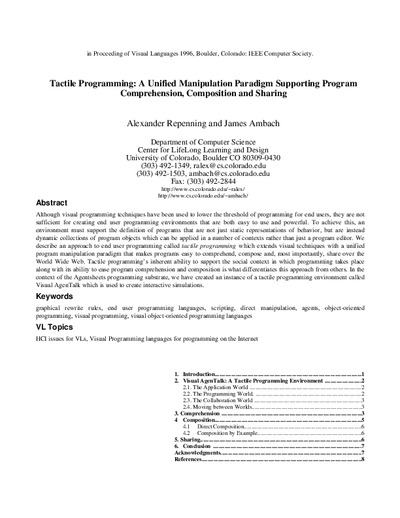Tactile ProgrammingAlexander Repenning, James Ambach
Erstpublikation in: Proceeding of Visual Languages 1996, Boulder, Colorado: IEEE Computer Society
Publikationsdatum:
|
 |
 Diese Seite wurde seit 1 Jahr inhaltlich nicht mehr aktualisiert.
Unter Umständen ist sie nicht mehr aktuell.
Diese Seite wurde seit 1 Jahr inhaltlich nicht mehr aktualisiert.
Unter Umständen ist sie nicht mehr aktuell.
 Zusammenfassungen
Zusammenfassungen
 Although visual programming techniques have been used to lower the threshold of programming for end users, they are not
sufficient for creating end user programming environments that are both easy to use and powerful. To achieve this, an
environment must support the definition of programs that are not just static representations of behavior, but are instead
dynamic collections of program objects which can be applied in a number of contexts rather than just a program editor. We
describe an approach to end user programming called tactile programming which extends visual techniques with a unified
program manipulation paradigm that makes programs easy to comprehend, compose and, most importantly, share over the
World Wide Web. Tactile programming’s inherent ability to support the social context in which programming takes place
along with its ability to ease program comprehension and composition is what differentiates this approach from others. In the
context of the Agentsheets programming substrate, we have created an instance of a tactile programming environment called
Visual AgenTalk which is used to create interactive simulations.
Although visual programming techniques have been used to lower the threshold of programming for end users, they are not
sufficient for creating end user programming environments that are both easy to use and powerful. To achieve this, an
environment must support the definition of programs that are not just static representations of behavior, but are instead
dynamic collections of program objects which can be applied in a number of contexts rather than just a program editor. We
describe an approach to end user programming called tactile programming which extends visual techniques with a unified
program manipulation paradigm that makes programs easy to comprehend, compose and, most importantly, share over the
World Wide Web. Tactile programming’s inherent ability to support the social context in which programming takes place
along with its ability to ease program comprehension and composition is what differentiates this approach from others. In the
context of the Agentsheets programming substrate, we have created an instance of a tactile programming environment called
Visual AgenTalk which is used to create interactive simulations. Dieses Konferenz-Paper erwähnt ...
Dieses Konferenz-Paper erwähnt ...
 Personen KB IB clear | John Seely Brown , Allan Collins , Allen Cypher , P. Duguid , Seymour Papert , David Canfield Smith , Jim Spohrer | |||||||||||||||||||||||||||
 Begriffe KB IB clear | AgentSheets
, blockbasierte Programmierumgebungenvisual programming language
,  Computerspiele Computerspiele computer game
, Paradigmaparadigm
, computer game
, Paradigmaparadigm
,  Programmieren Programmieren programming
, Programmiersprachenprogramming languages
, SimCity
, Simulation
, programming
, Programmiersprachenprogramming languages
, SimCity
, Simulation
,  WWW (World Wide Web) WWW (World Wide Web) World Wide Web World Wide Web
| |||||||||||||||||||||||||||
 Bücher |
| |||||||||||||||||||||||||||
 Texte |
|
 Dieses Konferenz-Paper erwähnt vermutlich nicht ...
Dieses Konferenz-Paper erwähnt vermutlich nicht ... 
 Nicht erwähnte Begriffe | AgentCubes, Scratch |
 Tagcloud
Tagcloud
 Zitationsgraph
Zitationsgraph
 Zitationsgraph (Beta-Test mit vis.js)
Zitationsgraph (Beta-Test mit vis.js)
 4 Erwähnungen
4 Erwähnungen 
- Programming Goes Back to School - Broadening participation by integrating game design into middle school curricula. (Alexander Repenning) (2012)


- ICER 2013 - International Computing Education Research Conference, ICER '13, La Jolla, CA, USA, August 12-14, 2013 (Beth Simon, Alison Clear, Quintin I. Cutts) (2013)
- The zones of proximal flow - guiding students through a space of computational thinking skills and challenges (Ashok R. Basawapatna, Alexander Repenning, Kyu Han Koh, Hilarie Nickerson) (2013)


- The zones of proximal flow - guiding students through a space of computational thinking skills and challenges (Ashok R. Basawapatna, Alexander Repenning, Kyu Han Koh, Hilarie Nickerson) (2013)
- Emerging Research, Practice, and Policy on Computational Thinking (Peter J. Rich, Charles B. Hodges) (2017)


- 18. Principles of Computational Thinking Tools (Alexander Repenning, Ashok R. Basawapatna, Nora A. Escherle)


- 18. Principles of Computational Thinking Tools (Alexander Repenning, Ashok R. Basawapatna, Nora A. Escherle)
- Medienpädagogik und Didaktik der Informatik - Eine Momentaufnahme disziplinärer Bezüge und schulpraktischer Entwicklungen (2018)
- Scalable Game Design Switzerland (Alexander Repenning, Anna Lamprou, Nicolas Fahrni, Nora A. Escherle)


- Scalable Game Design Switzerland (Alexander Repenning, Anna Lamprou, Nicolas Fahrni, Nora A. Escherle)
 Volltext dieses Dokuments
Volltext dieses Dokuments
 |  Tactile Programming: Artikel als Volltext ( Tactile Programming: Artikel als Volltext ( : :  , 291 kByte; , 291 kByte;  : :  2021-03-21) 2021-03-21) |
 Anderswo suchen
Anderswo suchen 
 Beat und dieses Konferenz-Paper
Beat und dieses Konferenz-Paper
Beat hat Dieses Konferenz-Paper während seiner Zeit am Institut für Medien und Schule (IMS) ins Biblionetz aufgenommen. Beat besitzt kein physisches, aber ein digitales Exemplar. Eine digitale Version ist auf dem Internet verfügbar (s.o.). Es gibt bisher nur wenige Objekte im Biblionetz, die dieses Werk zitieren.











 Biblionetz-History
Biblionetz-History